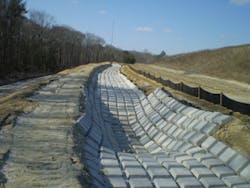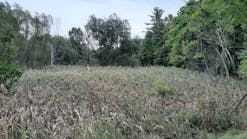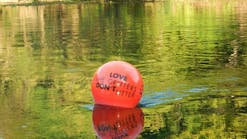Not too long ago, poured concrete and stone masonry were about the only choices engineers had when they needed to stabilize banks and prevent erosion in channels with high shear stresses. They succeed, but at a cost: Because they don’t allow stormwater to infiltrate into the soil, contaminants are carried along with the water to the outfalls, which often face greater erosion problems than the channels themselves because of the velocity the stormwater has built up along the way. In addition, these channels can look unnatural and interfere with wildlife habitat.
Engineers still determine the most appropriate channel lining based on the volume and velocity of stormwater in a given time frame, as well as the soil type, slope, and size of the site. However, a considerable amount of research and development has taken place through the years, and it’s given them a wide variety of choices to work with.
“There are appropriate solutions to any erosion control project,” says Patrick Dayan, an engineer with Miller Legg, a statewide consulting firm headquartered in Pembroke Pines, FL. “But there are also unknowns, such as site constraints, that drive the project at hand. Sometimes your vision gets shifted.”
Among the effective solutions are articulated concrete block (ACB) and cellular confinement systems. They stabilize the channel, slow the velocity of stormwater, and prevent erosion, even in high-velocity channels, as well as allowing water to move between the surface and the subgrade and letting vegetation to grow through them. They’re also flexible, resistant to freeze-thaw cycles, and aesthetically pleasing, and they allow for animal habitat. At the same time, they need little or no maintenance-they may need to be mowed occasionally-and can withstand being driven on. They all work best installed over a permeable geotextile.
Veronica Foster, senior engineer at Golder Associates Inc. in Mt. Laurel, NJ, has been specializing in this area for more than 10 years. “We know products of this nature have a proven record of working effectively,” she says.
Concrete block systems are blocks of either open or closed cells that form a mat. The mats are connected by cables or ropes, which give them their flexibility. Open cells and the spaces between the mats allow water to permeate, soil to infill, and vegetation to grow.
Cellular confinement systems are made of three-dimensional cells that can be filled with soil, aggregate, or poured concrete, depending on the requirements of the project. When they’re filled with aggregate-either as part of the landscape design or in arid areas where vegetation may not grow-or with soil, water infiltrates freely, but the soil or aggregate is confined in the cells. Filled with poured concrete, they provide a durable surface as well as a flexible slab.
Open-cell ACB and cellular confinement systems can be filled with soil and seeded during the project, or they can be left to fill with soil as sediment washes into them during rain events and reseed naturally. As vegetation grows through them, its roots anchor the system.
“The industry is developing so quickly, and there is such a wide range of products, including “˜green’ products,” Foster says. “One of the biggest challenges we face as designers is staying up to date about the wide varieties of materials that are available to us.”
Equalizer Channel and Retention Ponds
Not far from the stands in Legends Field in Tampa, FL, home to the New York Yankees during spring training, an equalizer channel joins two retention ponds.
The state of Florida requires owners to maintain existing facilities. In addition, he says, “the shorelines all around the ponds were eroded by wind and wave action and they’d lost about 10 feet of shoreline. They’d become so narrow that they couldn’t get mowing equipment around anymore.”
Ninety percent of the work done by Bio Mass Tech, which was founded in 1994 by the Griffin family in Land O Lakes, FL, is in maintenance construction and the restoration of existing facilities. For the Legends Field project, the company chose Presto Products Co.’s Geoweb cellular confinement system, which began as a joint venture between the Army Corps of Engineers and the company in Appleton, WI.
Taking upstream development into consideration wasn’t a factor in this project: The channel and the ponds are part of Legends Field’s self-contained stormwater system. Stormwater is pumped into one pond, and as the water level rises, it flows through the channel and into the second pond until the levels balance out. Water in the ponds is used for irrigation. If they get overloaded, stormwater flows into the city system.
“It’s all held together between the storm drains and the channel,” Griffin says.
The water in the channel never has very much velocity, so that wasn’t a consideration either. The crucial elements were the state’s sandy soils and a common-and legal-practice of many developers in the state.
“Generally what happens in Florida is that developers over-excavate retention ponds and use them as borrow pits to generate extra fill for the project,” Griffin says. “Five to 10 years after the project is complete, the original slopes start to migrate to the deeper part of the pond. This causes the slopes to start failing because of the fluctuation of the water levels and wave-action erosion. The sandy soils in Florida don’t hold up.”
Bio Mass Tech chooses the products it uses for channel armoring based on the specifications it’s given. “Over the years, we’ve determined which to use,” he says. “We feel stone-filled Geoweb is best for stability in Florida soils.”
Many soft-armor erosion control products are designed to slow the velocity of water, not retain soil, he says. When sandy slopes in Florida get saturated, the sand liquifies and bleeds right through blankets. The company does use coconut-fiber mats sprayed with hydroseed mixture for some of its projects. “It’s a budget fix. Soft armoring is about 25% of the cost of Geoweb. It’s very effective when used in the right site conditions.”
For the Legends Field project, crews imported a couple of hundred loads of clean fill to restore the shoreline. Because the bank was so narrow, they had to create a new one and build it flat so the machinery could use it as an access road. They worked backwards, grading and reshaping the banks into a 4:1 slope as they went.
They lay a geotextile over the fill, the 8-ounce nonwoven Mirafi 180N from TenCate, which is based in the Netherlands. The fabric is made of polypropylene staple fibers; it conforms easily to the ground, retains the soil, and is porous.
Crews then installed Geoweb, which holds the fabric in place. The Geoweb cell walls form a series of check dams throughout the system and confine the aggregate in the cells, which keeps it stable and still allows water to infiltrate. Geoweb comes in lightweight panels that can be easily handled on the site and can be stacked to withstand higher flows. Because it’s made from high-quality polyethylene, it also forms a flexible slab.
The cells were filled with a three-quarter-inch gray granite stone that was specified by the Yankees organization. The stone is decorative, so there was no need to infill with soil and revegetate.
“We only armored a small portion above and below the water level,” Griffin says, “only where the erosive forces are.” Crews placed the Geoweb within 2 feet below the water level and 2 feet above. The only time the system will require maintenance is if the water level falls below the armoring, but because reclaimed water can be used to keep the ponds filled, the water level will stay stable.The project covered 50,000 square feet and took about 60 days to complete. The budget was $260,000.
“We have very few problems with Geoweb, and it has never worn out,” says Griffin. “It’s the only product with which we feel comfortable enough to warranty our work for one year.”
Verada Channel Lining
Most of the time it’s just a ditch linking the storm drains in the neighborhood of Port St. Lucie, FL, to the North Fork of St. Lucie River, but during Tropical Storm Fay in August 2008, the horseshoe-shaped Verada Channel overflowed its banks and threatened nearby homes.
“We had a tremendous amount of rainfall,” says Patrick Dayan, who worked on the design. “About 16 inches fell in a very short time. It overextended the existing stormwater facilities, flooded a maintenance road, washed out an existing culvert under a road to homes, and shut down the road. The banks were failing, and there was serious scarping. In some places erosion was so severe that it was up to the chain link fences of people’s yards.”
St. Lucie County approached Miller Legg, which encompasses a number of consultants, including engineers, planners, landscape architects, urban designers, environmental wetlands consultants, and environmental risk managers, to bid on the emergency project. It involved both the Federal Emergency Management Agency (FEMA) and the Natural Resources Conservation Service (NRCS), and its “drop dead” date for completion was less than 90 days from design to installation. Bidding was accelerated, Dayan says. Design was also extremely accelerated. He and team members chose to arm the channel with Submar’s UltraFlex M4540 articulating concrete blocks (ACBs). “We had a great geotech firm, Andersen Andre, that made recommendations,” Dayan says. “We had our design within four weeks.”
The soils are mostly sandy, with some clay and other materials in some sections. And while the water level did get close to nearby homes during the storm, it didn’t get high enough to flood them, he says. “That’s the test of the capacity of that channel.”
The timing largely determined the type of armoring used, he says. UltraFlex mats are made from individual concrete blocks that are cabled together into site- and job-specific mats, and they can be manufactured and installed quickly. Submar used Dayan’s AutoCad file and cabled the blocks together according to the channel’s length, curves, “and other tricky geometry,” he says. “You always have to field-fabricate some things onsite, but the more you do upfront, the better.”
The physical layout was another factor. Although the company didn’t have to account for more development upstream, because the neighborhood is almost 100% developed, the channel itself was a challenge. It isn’t your typical channel, Dayan says. It was created decades ago, with a high point at the center of the horseshoe and two outfall structures that drain into the river at the ends. The right of way was only 100 feet, and the only area to drive on was a 15-foot-wide maintenance road, so there wasn’t the luxury of setting up a staging area. The company needed a channel armoring that could be brought in, unloaded, and installed in one shot.
The big question, says Dayan, was whether or not the project was going to be constructed in time.
Ranger Construction and Dickerson Florida Inc. reshaped the channel and excavated the toe in order to anchor in the mats, then added light amounts of fill. “We tried to keep the cross section equal to or greater than before,” Dayan says. “We didn’t want to decrease the capacity of the channel.”
Then the company compacted the soil, covered it with a geotextile by Propex, and began installing the UltraFlex mats. “Trucks were backing up to sometimes half a mile. They had to be unloaded one by one.”
Crews installed the mats from the toe of the channel, where most of the hydraulic action takes place, to the top of the bank, except where there were existing facilities, trees, private properties, or other obstacles. The height ranged from 6 to 7 feet to as high as 10 feet, which was 1 to 2 feet above the highest expected water level. Crews then backfilled at the toe as additional insurance to prevent scour from undermining the channel.
They backfilled the mats with soil and seeded them with local grasses and other vegetation, which will eventually cover 60% to 75% of the bank. The vegetation will require maintenance only if it becomes unsightly.
The cost of the project, more than 280,000 square feet, was between $5 million and $6 million. It began in March and ended in June, fewer than 90 days after Submar was first contacted about it.
“I think these mats are the Cadillac of erosion control,” he says. “You can install them on shorelines that get severe attacks.”
Indian River Generating Station
The Indian River Generating Station in Sussex County, DE, which is owned by NRG Energy Inc., generates electricity from coal. Byproducts, including fly ash and bottom ash, are disposed of in a landfill on the site that will be covered with an impermeable geosynthetic cap once the filling attains the maximum permitted grades to prevent erosion of the ash.
Stormwater from the landfill flows into a manmade perimeter channel that surrounds it. The channel drains into a forebay, a half-acre stormwater pond, where sediment settles out before the water goes into a larger pond, where it infiltrates, says Veronica Foster, who designed the project and specified Cable Concrete to armor the channel.
Preston Ayars, senior project manager for George and Lynch Inc., in Dover, DE, the contracting firm that built the channel in 2008, chose the closed-cell Cable Concrete system from International Erosion Control Systems Inc. in Ontario, Canada.
“The channel is essentially a hard-armored swale,” Ayars says. It was built to convey stormwater runoff from the landfill, its only source of stormwater. The underlying channel surface has sandy soils, a flat bottom 14 feet across, and 3:1 side slopes 1 to 2 feet high-higher on the curved portions than on the straighter ones.
Foster specified Cable Concrete for a number of reasons. The choice depends on the natural grades at the site and the regulations, she says. “But even when local regulations are for a 10-year storm, we design for a 25-year, 24-hour storm.”
A major consideration was the natural flatness of the land, resulting in channel slopes as little as one-half-percent. Shallower slopes require a larger channel than steeper ones and are a lot less forgiving: If a rock is in the wrong spot, you’ve created a pool. Cable Concrete is smoother than regular grass-lined channels, and smoother surfaces help convey stormwater faster than rougher ones.
In addition, she says, “If I used a more traditional lining protection to provide similar armoring, I’d have to use riprap, from 9 inches to 20 inches, and then I might not have the slope, or I’d have to add fill to make the slope higher. Cable Concrete is only 4.5 inches tall, and it can handle higher velocities.” The terrain was a challenge for equipment operators working on the project as well, because it was hard for them to construct such shallow slopes. They had to be very skilled, she says.
Before the vegetation is established, this channel can handle high amounts of runoff because it can convey stormwater quickly to the forebay. Over time, as sediment fills the crevices and vegetation takes root, it will begin to look less like an engineered channel and more like a natural one. If a very intense storm causes some fill in the crevices to erode, the sediment will settle in forebay.
Instead of installing the Cable Concrete over the geotextile, International Erosion Control Systems poured concrete into approximately 16 prefabricated molds to produce more than 400 mats. Each mold was a grid of 15.5-inch by 15.5-inch squares that created an 8- by 16-foot mattress, which was placed in the channel during installation. The top of each square was only 11.5 inches square, though.
“It looks like a pyramid with the top cut off,” Ayars says. “This creates space between each block for sediment to deposit and vegetation to grow, as well as the flexibility to allow the mattress to form-fit the swale bottom and sloped sides.” Crews set long stainless steel cables into the molds to join the blocks together, then filled them with concrete.
Finally, they placed an 8-ounce nonwoven geotextile made of 100% polypropylene staple filaments, US205NW from US Fabrics in Cincinnati, OH, on top of the concrete while it was still curing and attached it to the concrete with wires. They cut it two feet longer than the mats on three sides to provide an overlap on which to place the adjoining mats and prevent the system from being undermined.
“Having the geotextile preattached to the mattress is a little more labor intensive during fabrication, but you don’t have to worry about someone else rolling out the material and getting in the way, or about having the material blowing around during installation,” Ayars says.
The next day, crews flipped the mold over and had a concrete mattress with a geotextile base that conformed perfectly to the terrain, ready to install into the swale. They began laying the mats at the downstream end, allowing six inches as freeboard-the factor of safety above the design depth for intense storms.
“Because the mats are 16 feet long and poured in 15-inch sections, they’re very flexible,” he says. “We had to lift them from four points with a spreader bar or else they’d fold in on themselves.”
The channels will need very little maintenance, Ayars says. They can be cleaned up with a maintenance vehicle if too much sediment starts to form or if the vegetation needs mowing. If a mat needed repair, crews could dig the sediment out and pour in a little concrete.
The price is comparable to riprap; however, Cable Concrete requires much less fill to create the swale’s sloped sides. The entire project took about four months to complete; the Cable Concrete component about one month.
“It was pretty easy,” he says. “We’d never done it before and it went quicker than we’d thought. The learning curve was very short, which helped create an on-time project for the owner.”






